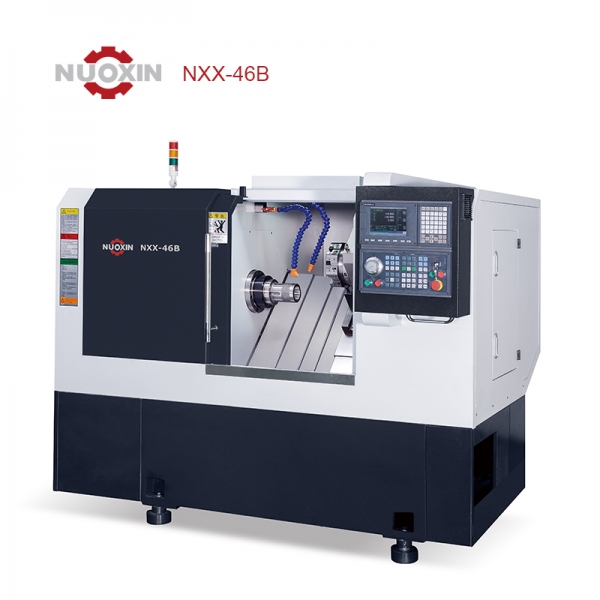Turning and milling composite CNC lathe manufacturers talk about the technology of turning and milling combined machining center
Turning and milling composite CNC lathe is a typical high-precision, high-efficiency, high-rigidity, high-automation, high-flexibility milling and turning complex center. The Turning and Milling CNC Lathe is a state-of-the-art composite machine that combines the performance of a five-axis simultaneous milling center and a dual-spindle lathe. It provides a better solution for processing high-precision, high-quality, high-complexity small parts.
With the rapid advancement of the world's science and technology, many products are developing in the direction of miniaturization and miniaturization. A large number of small precision CNC machines are often needed to meet the needs of users. In the current Chinese machine tool products, there is a lack of such high-precision CNC machine tools. In addition to being widely used in the watch industry, medical equipment, auto parts manufacturing and other light industry sectors, it can also be used in aerospace, weapons, ships. Processing various sophisticated and special special parts such as flight control gyroscopes, air-to-air missile inertial parts, aerospace connectors, aircraft engine disk shaft parts, aircraft engine nozzles, blades, and hydraulic instrument precision. Parts, electromechanical liquid gas and light related to various sophisticated parts, etc., are high-quality machine tools suitable for small precision and complex zero-machining on the market.

The turning and milling combined machining center has no special requirements for the machine tool, but at least one Y-axis motion is required. The rotation of the workpiece provides the C-axis motion for the milling cutter to deliver the required feed rate (power). However, the cutting speed that the workpiece needs to achieve is measured in ipm instead of the lathe (which means that the workpiece is in the turning-milling machining center, which is much lower than the cutting speed when turning). However, the Y-axis motion is needed because the milling cutter has to do a lot of eccentric machining. Moreover, when the tool is eccentrically machined, it cannot be machined to the required size of the part. Because the tool center is at the center, the tool center and the rotation center of the part just intersect, and the tool can only use its end face for cutting (ie, can not be cut), instead of using Its cutting edge is cut. To ensure proper cutting of the cutting edge, the tool centerline will have to offset the part rotation centerline to 1/4 of the tool diameter.
In the machining of turning and milling machining centers, there are three types of tools that can be used effectively, mainly due to the use of wiper blades or cutting edges. For face milling in car-milling, large flat or heavy-duty intermittent cutting is possible. Insert end mills are used for step milling. Use integral end mills to machine outer circle parts and finish milling deeper narrow grooves. The wiper blade structure of the above tool achieves high-efficiency and high-precision machining by cutting two of the four cutting edges of the tool to the depth of the part. However, with this method, problems occur when the tool is machined close to one step and one groove. At this time, after the eccentric tool is processed, many rounded corners will be left on the surface of the part. In order to machine these fillets, the tool must be machined a second time. At this time, the tool skew is no longer required, and the tool is moved along the Y axis to the center of the part for machining. This time, the so-called secondary processing, can not cut into the metal material (sometimes need to leave some margin processing), unless the step must be cleared, which is not allowed in actual use.
In the machining of turning and milling combined machining centers, the fact that it is unsatisfactory despite its dissatisfaction is the shape error of the machined parts. When the milling cutter performs circumferential milling around the part, it will inevitably form some regularly spaced scalloped marks on the surface of the part. This error cannot be completely eliminated, but it can be effectively controlled using a wiper blade. A wiper blade is followed by the other blades, causing the cutting edge to protrude slightly in the width direction, so that the cutting edge of the blade extends just into the surface of the machined part, a new cutting surface is machined, and the fan-shaped traces are slightly flattened.
The address of this article:http://www.777y.com.cn/en/news/400.html
Key word:車銑復(fù)合數(shù)控車床廠家,小數(shù)控車床廠家,數(shù)控車床定制廠家
The next one:Small CNC lathe manufacturers talk about the relationship between precision and resolution of CNC machine tool encoder
Recently browse:
Related news:
- Small CNC lathe manufacturers talk about common sense in lathe power supply
- Turning and milling composite CNC lathe manufacturers talk about the main components of CNC lathes
- CNC lathe custom manufacturers talk about the daily maintenance of lathe oil mist system
- Turning and milling composite CNC lathe manufacturers talk about the division of CNC machining process
- What are the requirements for the use of turning and milling composite CNC lathes?
- Small CNC lathe manufacturers talk about the relationship between precision and resolution of CNC machine tool encoder
- CNC lathe custom manufacturers talk about the advantages of integrated cast iron slant bed
- CNC lathe custom manufacturers to describe the positioning accuracy of small CNC lathe linear motion
- Small CNC lathe manufacturers talk about the future development of turning and milling composite CNC lathe
- How to improve the processing efficiency of small CNC lathes for CNC lathe custom manufacturers


















